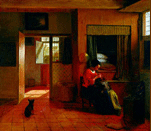20.
Sibling Treasures: Sororal Relations
in Early Modern Music, Art and Literature
Organizers:
- Linda Austern, Music, Northwestern University
- Naomi Miller, English, University of Arizona
- Naomi Yavneh, Humanities, University of South Florida
Description:
While the relationship between parent and child has been a staple of critical
inquiry since antiquity, the bonds between siblings have received less attention.
Indeed, despite early feminist acclamations of sisterhood, as well as the
explosion of scholarly interest in reconsidering the complexity of women’s
roles in the early modern period, actual sisters and brothers have been rather
neglected. Yet sibling relations are at least as complicated and compelling
as filial or even maternal ones. Sisters, for example, were often constructed
as their brothers’ “treasures,” both because they could
be married off and because they looked out for their brothers’ interests,
monetarily, socially or even emotionally. At the same time, sororal bonds
were very important in enabling women to survive the social strictures that
contained them.
Through opera, motet, portraiture and drama from Italy, France and England,
our workshop considers the sororal bond—whether created through blood,
law, religious vow or bond of affection—as a starting point from which
to explore the intricacies of gender and class structures as well as religious
and artistic hierarchies in the early modern period.
Music was one of the activities shared by groups of women in early modern
Europe, particularly within such homosocial environments as girls’ schools,
convents, and living quarters of gentle and noble households. Ensemble participation
in music not only brought women together in literal and figurative sisterhood,
but also entertained, helped relieve the tedium of such collective tasks as
mending or embroidering cloth, and served as a means to learn and collectively
express shared religious faith. The male homosocial music of tavern and barber-surgeon
has long been recognized, but women’s music, often used in domestic
space by women connected by blood or other social ties, has been slower to
attract scholarly attention. Demonstrating the more recent advance of feminist
thought into the traditionally conservative realm of musicology, Linda Austern
will invite participants to consider some of the ways in which musical sisterhoods
operated and were represented, including Italian convent music (performed
by sisters within a single house of a single religious order), a French opera
that musically portrays sororal behavior, English publications dedicated to
women for use with the women of their households, and an English opera which
depicts sisters of the heart and was performed at a girls’ school.
Questions to consider:
- How did women use ensemble performance by and for members of their various
sisterhoods in order to transcend limitations placed by men on women's
musical practices?
- How did such close groups of women use music to reconfigure women-only
spaces to become equal to men's and public spaces?
- What kinds of hierarchies of age, kinship, and friendship were expressed
through musical performance, especially among multiple sisterhoods across
generations?
Naomi Yavneh will invite exploration of sorority from a visual perspective
through a consideration of Italian family portraiture. “The Chess Game”
(1555), Sofonisba Anguissola’s group portrait of three of her sisters
and a female servant, is unusual for numerous reasons—including that
any work by a young woman admired by Michelangelo and celebrated by Vasari
is perforce extraordinary. Not only is the servant’s presence uncommon
in group portraiture, but Vasari himself commented on the originality and
life-like qualities of the figures, whose lively good-humor is a remarkable
new twist in a genre usually depicting somber and stiff individuals. Moreover,
the sisters (the needlework of whose garments is represented with astonishing
detail) are playing chess—usually presented as a masculine game of intellect
and power. In effect, the sororal chess game might be regarded as akin to
the acts of ensemble performance by the sisterhood referenced above. The painting
invites consideration of sororal strategies of degree, priority, and place,
particularly in terms of the artist’s use of sibling relations to transcend
traditional hierarchies not only of gender, class and space but also of genre.
Questions to consider:
- How do sisterly relations enable Sofonisba to transform the genre of
portraiture and in what ways is that transformation informed by her class?
- How do sororal bonds work to transform the traditionally accepted hierarchies
of “manly” art over such apparently female crafts as needlework?
- What can we extrapolate from Anguissola’s unusual oeuvre to help
us better understand the intricacies of gender, genre and class hierarchies
in more traditional, male-created works of the period?
Turning from portraiture to drama and from Italy to England, Naomi Miller
examines the complex connections among siblings by blood and “in law,”
when sharing the same familial space, both physically and socially. Attending
to dramatic representations of sibling relations by both male and female authors,
one finds that sororal and fraternal bonds are brought into parallel relation
even as they are pitted against one another. While women’s bonds are
apparently overshadowed in the social arena by the more public posturing of
male brothers and friends, private correspondence between early modern sisters
and female cousins suggests an enduring network of connections designed to
outlast masculine jockeying for social position. In effect, these women construct
their own ensemble opportunities on the stage of gender relations. For the
purposes of the workshop, Naomi Miller will invite consideration of sibling
relations represented by female and male dramatists, encouraging particular
attention to of the conceptual frameworks according to which sororal voices
find audiences. A consideration of sororal relations as articulated in private
correspondence will offer an additional window into sibling strategies of
degree, priority and place.
Questions to consider:
- How do sororal and fraternal bonds intersect differently in familial
representations constructed by female and male authors? By writers from
different ranks of society?
- What are the primary factors distinguishing sororal relations by blood
and “in law”?
- How did the conventions of the drama shape representations of sibling
relations on stage?
- How do glimpses of sororal sibling relations in private correspondence
of the period shed new light upon the gendering of familial hierarchies
within dramatic and other literary conventions?
The interests and backgrounds of the three organizers represent the expansion
of our field in the past twenty-five years, while suggesting areas for further
growth. Although the three facilitators are inviting consideration of sibling
relations in three distinct disciplines, the intent of the workshop is to
use sororal bonds, viewed in both commmunicative and competitive iterations,
as a focal point for a productive interdisciplinary exchange. There is a short
list of required readings and musical and visual examples to encourage workshop
participants to introduce and draw upon examples from their own disciplines
that might contribute to the overall workshop discussion.
As facilitators rather than lecturers (each of us will provide
a presentation of no more than five minutes in order to help shape the terms
of the discussion), our goal is to increase interdisciplinary dialogue by
interrogating the construction of sibling relationships and their interplay
with concepts of hierarchy across disciplines and national cultures to bring
a wide variety of participants into an informed and informing conversation.
Required Reading/Listening (approx. 30 minutes):
Music for and recordings of (brief excerpts):
- Chiara Margarita Cozzolani, “Dialogues with Heaven”
- Isabella Leonarda, “La musa Novarese”
- Jean Baptiste Lully, Psyche (opera)
- Henry Purcell, Dido and Aeneas (opera)
- Lucrezia Orsina Vizzana, Componimenti musicali (music book by nun for
nuns)
Images by Sofonisba Anguissola (self-portraits and “Chess
Game”) as well as family portraits by male contemporaries
- Brief selections from Giorgio Vasari, Lives of the Artists
- Brief selections from Lady Mary Wroth, Love’s Victory
Elizabeth Cary, The Tragedy of Mariam William Shakespeare, The Winter’s
Tale John Webster, The Duchess of Malfi
Excerpts from the private correspondence of Lady Mary Wroth and her sisters-in-law,
Dorothy, Countess of Leicester, and Lucy, Countess of Carlisle.
Images by Sofonisba Anguissola (self-portraits and “Chess
Game”) as well as family portraits by male contemporaries
The required materials for the workshop, as well as suggestions
for further reading and tools for interactive discussion, will be available
both before and after the conference to participants on a “Blackboard”
website (to be provided by Naomi Yavneh’s institution, USF).





















